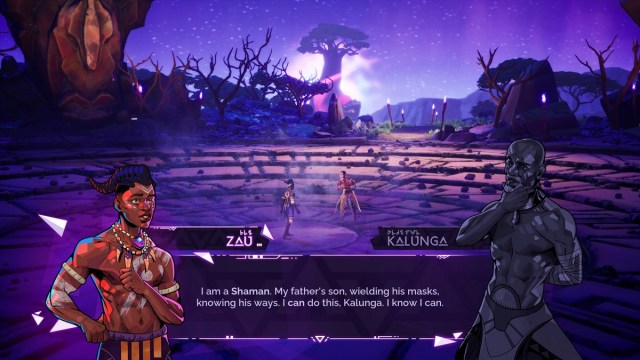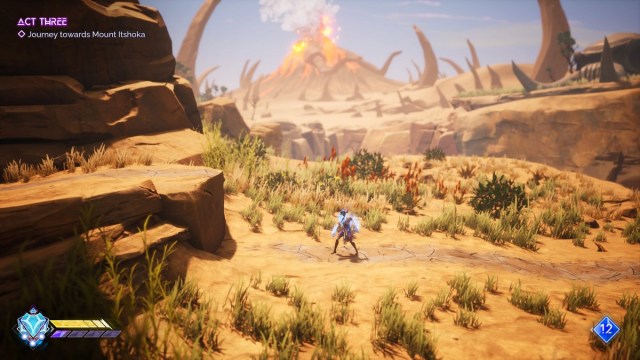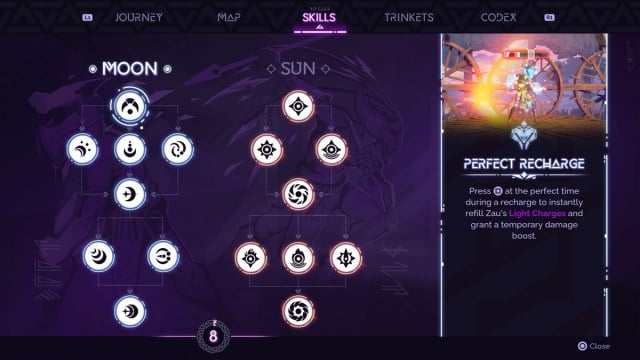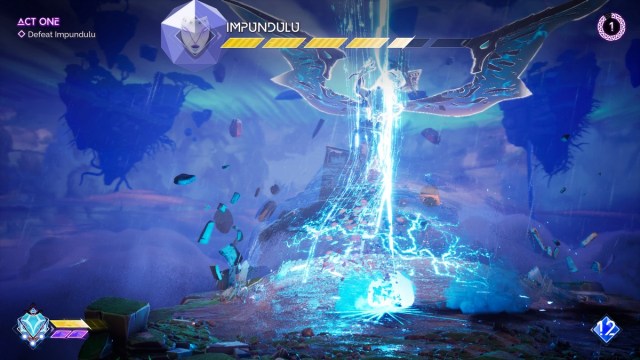Tales of Kenzera: ZAU on PlayStation 5
The Metroidvania genre is full of gems that have strong gameplay foundations, keeping players engaged in whichever world they find themselves in, and incentivizing them to keep coming back for more. That said, not many of them feature stories that touch upon more poignant themes that require more emotional investment from the player. This is where Surgent Studios’ Tales of Kenzera: ZAU shines brightly, even if there are several issues that dim its brilliance along the way.

With the central core of the story being about the love of a father and son, players will join Zuberi, a child who is now mourning the loss of his father, in the distant future. That sense of loss is profound, and the only way to placate the unnerving swell of emotions is through a book written by his father, of a shaman called Zau who is facing the same predicament in the lands of Kenzera. Yet, the healer is able to strike a deal with the God of Death, Kalunga. By overcoming three lost ancestral spirits, Zau wants the deity to bring his Baba back from the dead.
The rest of the tale is best discovered on your own, and there is little doubt that the human story at the center of it all amps up the appeal of this 2.5D adventure. The performances of the cast are a joy to experience, with the voice acting, especially of Kalunga and Zau, amplifying the stakes involved and the emotional growth that awaits. Losing a loved one is never easy, and Abubakar Salim’s own experience certainly comes to the fore when performing as Zau. The balance struck by the contrasting and usually more level-headed Kalunga makes the pair an engrossing watch and, in turn, immerses players deeper into the journey.
But that story doesn’t just develop on its own, with players nudging Zau along as he tries to fulfill his side of the bargain by navigating unique environments and overcoming the dangers within. The usual works of fatal spikes, disappearing platforms, and timed sections are familiar sights, but Tales of Kenzera: ZAU also throws in more interesting challenges built upon the lore of Bantu tales. The stories and legends of these native African ethnic groups are as colorful and memorable as they come, and when woven into the game, they serve as an important cultural gateway that allows us a peek into Zau and his people, as well as the inspirations behind the setting.

How this manifests is often through the cosmic powers granted by the sun and the moon, wielded by Zau through the appropriately named Sun and Moon Masks. Against the restless spirits and even the immensely more powerful ancestral beings, the two mirroring tools are invaluable when it comes to progressing the story. The Moon Mask can manipulate time and freeze things, whereas the Sun Mask can help power up devices or dissemble constructs, and as players continue to expand their powers and abilities, Kenzera will continue to open up, and, subsequently, put your skills to the test if you are hoping to see everything there is to offer.
That ability to seamlessly switch between the two masks also comes in handy when combat ensues in Tales of Kenzera: ZAU. The spirits that stand in Zau’s way are no slouches, and beyond their sheer numbers, they also mix things up with movesets and abilities that force players to adapt on the fly. When facing multiple enemies, it is often recommended that players always be on the move, using the ranged attacks of the Moon Mask to weaken foes and finishing them off with a strong melee flurry using the Sun Masks.
However, elemental shields can mess up your flow if you are not careful, and with limited space to work with most of the time, there is an added strategic element in the combat that helps make things more tense and exciting. Seeing Zau in full flow, using the full power of the shaman masks in rhythmic combat, is a sight to behold, and with plenty of situations that call for force to overcome, it helps keep things moving along briskly. Ulogi earned from vanquishing enemies can then be put into upgrading Zau’s skills, giving him more utility when wielding either the Sun or Moon Masks and making combat encounters even more enjoyable and manageable.

All of the preparation will be very helpful when Zau finally comes face to face with one of the great ancestral sprits, which are thankfully not just straightforward combat affairs. These foes can be tricky, testing players not just on how well they can do in combat, but also their ability to navigate quickly across obstacles. The chase sequence with the Kikiyaon stands out particularly for the latter, subverting my expectations for what constitutes a boss fight.
Between the combat and the platforming that develops into more daunting gauntlets, it is easy to understand the appeal of Tales of Kenzera: ZAU. The game strikes a nice balance between introducing a new mechanic and having players master them. Needless to say, as a Metroidvania, players armed with all of the skills can explore more freely to discover the hidden treasures that are found in differing areas of the Ikakaramban Highlands, Kivulian Forests, and Itshokan Deadlands.
This could be in the form of platforming challenges that reward Trinkets, useful items that can be equipped for passive bonuses, or giant trees with a space for reflection, fleshing out Zau’s relationship with his Baba even more while granting an increase in health. It pays to explore the world of Kenzera fully, and it is not just for the marvellous sights and sounds either.
These all come together in making players feel like the five to seven hours spent in Kenzera could have been longer, such is the quality on show for the majority of the game. Unfortunately, there are still details in Tales of Kenzera: ZAU that can dampen that enthusiasm, depending on your preference. For starters, controlling Zau doesn’t feel as tight as it should, with the 2.5D aesthetic sometimes getting in the way of informing players of their bearings. While the floatiness of the character is something players will get used to, the game has several sections that allow for just too little room for error. It can be frustrating trying a jump over and over again just to see where exactly a spike becomes fatal, and that’s just one example.

Combat isn’t exactly an equal scale either, with the Moon Mask’s ranged prowess proving to be more useful and efficient compared to the melee attacks and general sluggishness of the Sun Mask. Only when enemies came packing shields that required a fiery riposte did I feel the need to switch over to the Sun Mask. After all, staying far away from danger makes survival that much easier when Zau can be overwhelmed by enemy numbers quite easily.
The new mechanics that are introduced to players can also do with a little readjusting when it comes to filling out the world in Kenzera. Learning a new skill should come in handy in just a handful of places, and although there are sections that mix in every obstacle quite nicely, most of the areas in the game are usually one-off in that aspect, which can be a bummer.
Yet, at the end of the day, what could have been just a run-of-the-mill Metroidvania is transformed into a tale of growth and resilience in Tales of Kenzera: ZAU that is well worth the investment. With Kenzera being an utterly beautiful place full of mysteries and wonders, joining Zau and Kalunga as they fight and platform their way across delightful biomes in a bid to let go and move on became a therapeutic journey that I never knew I needed. We don’t need actual loss to remind ourselves that things can be difficult, but having a reminder goes a long way in keeping us all on the right track of focusing on joy instead of grief.
Tales of Kenzera: ZAU
Yet, at the end of the day, what could have been just a run-of-the-mill Metroidvania is transformed into a tale of growth and resilience in Tales of Kenzera: ZAU that is well worth the investment. With Kenzera being an utterly beautiful place full of mysteries and wonders, joining Zau and Kalunga as they fight and platform their way across delightful biomes in a bid to let go and move on became a therapeutic journey that I never knew I needed. We don’t need actual loss to remind ourselves that things can be difficult, but having a reminder goes a long way in keeping us all on the right track of focusing on joy instead of grief.
Pros
- Narrative and characters delivers huge impact.
- Excellent visuals and sound.
- Combat and platforming work well together.
- Cultural inspirations are unique and interesting.
Cons
- Controls could be tighter.
- Balancing issues both for combat and platforming.
A copy of this game was provided by the publisher for review. Reviewed on PlayStation 5, Nintendo Switch, Xbox Series X|S, PC.













